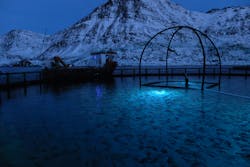LEDs keep salmon free of sea lice, boost yield and profit
LEDs continue to amaze in life science applications, and Signify has made that point abundantly clear in the announcement of the Philips Seacage 340W luminaire designed for aquaculture applications. The solid-state lighting (SSL) product is designed for submerged usage. Signify called the product a fish light but it actually is said to drive the fish into deeper water where the farmed fish avoid the dangers of sea lice.
We have been contemplating a feature article that discusses all of the ways that LEDs might be used in aquaculture or in other animal- and life-science applications. A number of years ago we wrote about how LED lighting could improve poultry production. It has also been used to increase milk production in dairies. And of course we all know about horticultural lighting. Go back seven or eight years, and we viewed horticultural SSL applications as just another life-science niche and now it’s virtually an industry unto itself.
The amazing thing about LEDs in such applications is the variety of ways that the technology is applied. And it’s a combination of inherent efficiency, the ability to tune spectra, and the fact that LEDs can serve in harsh environments that together deliver versatile uses.
In fish-centric applications, manufacturers sell submersible LED products that attract fish, even for personal boats. Signify is using its Seacage product in part to do the opposite, although sea lice are only part of the story. The artificial lighting with an engineered spectra allows the farmers to fool the fish into thinking that it’s always summer, thereby keeping the fish in a growth stage (called the on-growing stage) and forestalling a transition to a spawning stage. The technique maintains top quality in the harvested products and works with other fast-growth species including seabass and seabream, according to Signify.
The combination of higher-quality fish and elimination of the need for sea-lice treatments delivers return on investment. Signify said farmers can mount the luminaire 5m below the surface, causing the fish to swim below the sea-lice belt and reduce treatment needs by 50%.
“We help our customers to maintain constant production and at the same time improve the welfare and sustainability of the fish,” said Remco Lansbergen, general manager of aquaculture at Signify. “The Philips Seacage 340W fish light is robust and easy to handle. On top of improving growth rates and significantly reducing sea-lice exposure, our new energy-efficient light lowers the food conversion ratio, resulting in lower production cost.”
Just as with the case of horticultural lighting, other agricultural and aquacultural applications for LEDs require applied research. Signify has worked with the researchers at the University of Stirling in Scotland and at the University of Bergen in Norway to understand the impacts of light spectra and intensity on fish from the hatchling to on-growth to harvest stages. The company said proper artificial lighting can reduce mortality by 15%.
As for horticultural applications, we are moving forward with plans for our first virtual presentation of the HortiCann Light + Tech conference on Oct. 20–21. With the continuing coronavirus pandemic, we made the difficult decision to hold the event online for 2020. Registration is ongoing.
For up-to-the-minute LED and SSL updates, why not follow us on Twitter? You’ll find curated content and commentary, as well as information on industry events, webcasts, and surveys on our LinkedIn Company Page and our Facebook page.

Maury Wright | Editor in Chief
Maury Wright is an electronics engineer turned technology journalist, who has focused specifically on the LED & Lighting industry for the past decade. Wright first wrote for LEDs Magazine as a contractor in 2010, and took over as Editor-in-Chief in 2012. He has broad experience in technology areas ranging from microprocessors to digital media to wireless networks that he gained over 30 years in the trade press. Wright has experience running global editorial operations, such as during his tenure as worldwide editorial director of EDN Magazine, and has been instrumental in launching publication websites going back to the earliest days of the Internet. Wright has won numerous industry awards, including multiple ASBPE national awards for B2B journalism excellence, and has received finalist recognition for LEDs Magazine in the FOLIO Eddie Awards. He received a BS in electrical engineering from Auburn University.





